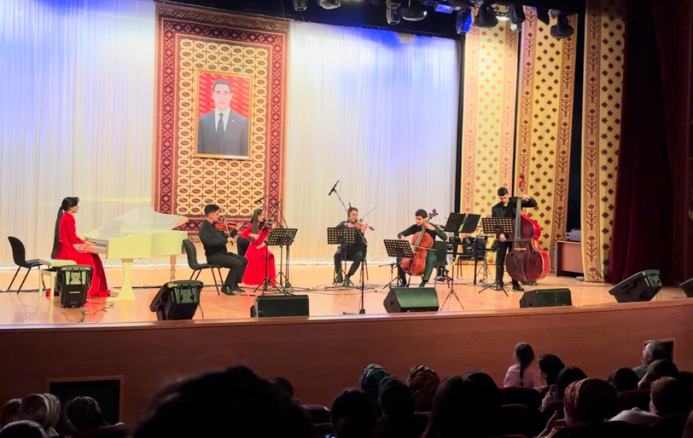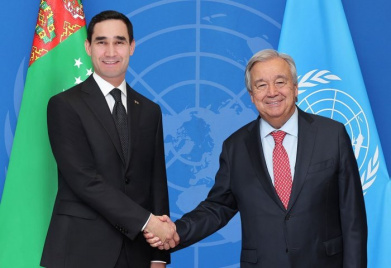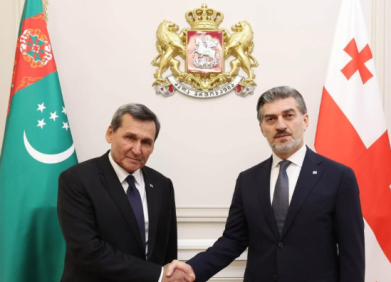Ashgabat now has its own camerata
08.02.2023 | 00:57 |While on one of his tours abroad, Turkmen violinist Bahram Dolyev, having attended a chamber music concert, decided to create a collective of the same format upon arrival. From that moment, we can say, the chronicle of the musical collective "Camerata Ashgabat" began, although at that time Bahram himself was still studying at the conservatory and the suffix "hiv" was not used at all when referring to him. Today he is Bahram Byashimovich, a teacher at the Turkmen National Conservatory, a laureate and winner of many awards in various creative competitions. And then, he was just a student dreaming of his creative team, together with which it would be possible to create interesting concert programs. Bahram nurtured the idea for a long time, looked closely at the repertoire, assessed his strength and capabilities, thinking about all the difficulties that could be on the way.
"After all, there are the Moscow Camerata, the Camerata of Kazakhstan or the Camerata of Belarus and many others. Ashgabat should also have its own camera," the young musician thought.
Time passed. Bahram completed his studies, joined the conservatory and even managed to create a new orchestra with his friend Tahir Atayev. As part of their successful joint project, the young violinist honed not only his performing skills, but also the skills of an organizer. One day he realized that it was time to move from words to deeds, that it was time to start building his own musical "ark". And then he began to gather musicians. No, not a couple, of course, but also different. To be sure to be professionals and masters of their craft. After all, in chamber compositions, all the musicians are literally "under a magnifying glass", and they are clearly visible, that is, audible.
The individual creative contribution of each of the participants is important here. So, there is no place for stowaways and hares on this musical ark. Playing unprofessionally, trying to get lost or disguise yourself behind the backs of others, as is often the case in symphony orchestras, will not work here. Having gathered a team of like-minded people, having picked up a repertoire with them, having organized the first rehearsals, Bahram saw how his idea of creating a new team was gradually becoming a reality. Overcoming difficulties - technical, administrative, creative, Bahram stubbornly told himself: "Camerata be! Let there be camerata!"
And so, on July 3, 2022, the Ashgabat camerata launched into free swimming, confidently keeping afloat and showing excellent musical maneuverability. The initial course was taken towards national music, world music classics and pop. Such a wide range of "playability" of camerata for ordinary listeners is only good. Everyone can get what they like.
The range of musical styles and epochs of this "newborn" collective extends from the Baroque to the latest innovations in musical art, which allows camerata not only to sail confidently on the waves of the ocean of music, but also, as they say, to be on the "same wave" with their listeners. And one more interesting detail, choreographic compositions are organically integrated into the repertoire of the camerata, like in a puzzle. This, of course, is not quite typical, but the experiment was a success. And now at the concerts of the new band, there is something to listen and see.
In general, the name of the camera in itself is very responsible and obliges to a lot. After all, it was the Florentine camerata, the very first of the world-famous camerata, information about which is in all encyclopedias, in the 16th century gave all mankind the opportunity to enjoy the art of opera. We still feel the beneficial result of the activities of the founder of the Florentine Camerata, Giovani Bardi, even after more than four centuries. In connection with all this historical context, a huge responsibility falls on the shoulders of the participants of the Ashgabat Camerata. You should always keep the brand and not lower the quality bar.

The selection of the repertoire for each of the concerts takes place jointly. Each of the participants puts forward their ideas and thoughts. During the controversy and general discussion, the program of the next concert gradually emerges. Also with rehearsals. Every nuance and touch is discussed and the best of the proposals is chosen, which most accurately conveys the composer's idea.
In addition to Bahram Dolyev, the camerata includes teachers of the conservatory: violinist Akmurat Kurbanov, violist Tahir Atayev and cellist Kakageldy Khojalekov, as well as double bassist, 1st year student of the Conservatory Ismail Sakhetmyrdov. The decoration of the camerata is the talented violinist Aylar Batayarova and pianist Abadan Meredova, who, having barely entered the first year of the conservatory, is already performing on the concert stage.
Oboist Didar Yomudov, 2nd year student of the Conservatory drummer Ovezali Nazarov also play with the band, and vocalists Dovran Shammyev, 5th year student of the Conservatory and Begench Moshshiev perform.
A young musician, conductor Dovlet Okdirov, helps the guys very much with the arrangement of the works. For example, for the recently held January concert, he arranged the work "Princess of Melancholy" by Azerbaijani pianist and composer Aziza Mustafa Zadeh, written for piano. In this composition, the listener can hear favorite oriental motifs, fragments from mughams, and the young ballerina Jennet Nyyazova, who came out to dance to this music in a national Azerbaijani costume, looked very organic.
The invariable "feature" of all camerata concerts is that the first number is performed without prior announcement, and the entertainer appears after the piece is performed. This time, for example, the concert opened with a performance by Kakagelda Khojalekov, who performed Bach's "Partita".
And also in the recently held concert, stage-winning and spectacular works were performed, such as the tango "Death of an Angel" by Astor Piazzolla and "Suite of St. Paul" by Gustav Holst. They, as expected, produced a "wow" effect. These compositions, complex in rhythmic and harmonic terms, demonstrated the coherence and teamwork of the musicians, well, in Grigorash Dinik's "Lark" the musicians famously flashed virtuosity, filigree technique and elegant lightness. The program also included performances with vocal compositions "I Love for Two" by Salvador Sobral, "Melodrama" by Andrea Bocelli and "In Memory of Caruso" by Lucho Dalla.

"But teaching students is still more difficult than playing on stage yourself," Bahram admits. – It's much more responsible. It's easier to play yourself a thousand times while you teach them something.
I am ready to subscribe to each of these words of Bahram. Since I saw all the guys from this team as schoolchildren, and even taught some of them. I remember telling Tahir off for not doing his homework, or making a stern remark to Bahram in the school corridor for making noise. Yes, I was a strict teacher.
I remember Kakajan Khojalekov's final exam, or here's a moment with Didar Yomudov, who, after winning a music competition, happily calls his parents to share the good news. And I also remember the thin and ringing Abadan, which my mother picked up from school every day after classes...
Now they are already adults, bright and charismatic personalities, professional musicians, teachers, someone already has families and children. It's great to see them such masters of their craft, to see how the audience applauds them and exclaims "bravo!". I remember looking at wedding photos of my grown-up and grown-up students and was touched. And as for the strictness, I think that, having become teachers themselves, they forgave me all my excessive demands.
Since its foundation, the camerata members have already managed to prepare four concerts. One of the performances, by the way, took place within the walls of the conservatory, as part of the festival "Young Talents". The high level of musicians' skill and high-quality performance were noted even by the rector of the conservatory himself.

The composition of the camerata is "sliding". That is, depending on the work and the score, the number of participants and instruments may vary. Such a "camera transformer" with high-class musicians, with a wide range of works, as well as with a very correct approach to doing business, from the point of view of modern reality, can be much more advantageous than a large symphony orchestra. After all, with a small, compact and mobile team, it is much more convenient to go on tour and concerts than to take out, for example, a whole symphony orchestra.
The young promising team is currently at the stage of its active creative development. The guys are looking for new ways and new solutions. But now Ashgabat has its own camera!
Ayna SHIROVA











